Lure making is an unusual hobby which tends to attract unusual people. Now, before I start getting abusive phone calls from lure makers all over the country, I’m certainly not implying that being unusual is such a bad thing.
For a start, people who take something they are passionate about and try to turn it into a business usually dream of immediate success and huge financial rewards. Unfortunately, if your preferred pastime is lure making that’s statistically unlikely to happen. I know quite a few lure makers and can’t think of a single one of them who’s made a fortune out of it, at least not from hand-made wooden lures. Some (I repeat, some) make a decent living out of it, but rich? I don’t think so.
It’s not the sort of profession which attracts lazy folk either. If you think lure makers just sit around all day playing with lures and go fishing any time they feel like it, you’re sadly mistaken. Most lure makers I know have less spare time to go fishing than I do, and I can tell you that isn’t nearly often enough. Then, even when they do get to go fishing, it’s usually more about testing a new prototype or refining a certain aspect of their lures rather than just relaxing and enjoying time on the water.
Finally and I guess not surprisingly, lure making is not the profession for people who think near enough is good enough. No sir, most lure makers I know are pretty fanatical about quality control and the finish of their lures. With these guys, everything has to be ‘just so’ and even a tiny run in the clear coat can be enough to relegate a perfectly good lure to the ‘not for sale’ ranks.
Of course, for every rule there’s an exception and guys like the late Ken Hendry (of Seeker fame) and Les Barlow from down Stanthorpe way are perfect examples of what I fondly refer to as the ‘Old Guard’ of lure makers who took a more pragmatic approach to their craft. Both of these gentlemen built lures which put function and performance well ahead of pretty paint jobs. I guess that’s one of the reasons why Seekers are such collectable items these days, as they really encapsulate the no-nonsense persona of their creator.
Ken and Les aside, most other members of the lure making profession are nit picking perfectionists. Heck! You can even buy lures from a maker who goes by the name of OCD (Obsessive, Compulsive Disorder) Lures, and if that doesn’t give you an insight into how fanatical most lure makers are, I don’t know what will.
While last century (doesn’t that sound so long ago?) produced some of our most iconic lures with the likes of StumpJumpers, Scorpions, Kaditachas, Bennett McGraths and so on, it’s a mistake to think that hand crafted wooden lures are a thing of the past. Sure, a lot of the pioneers of lure crafting have called it a day but thanks to a recent surge of interest, I see lure making as very much a contemporary hobby. In fact, there are probably more people out there now hand making lures than there have ever been. If you think I’m mistaken, get on the ‘net and check out the Lure Lovers, or Lure and More websites for yourself.
If you’re still not convinced, there’s a little event called the Australian Lure & Fly Expo held on the outskirts of Brisbane each year. The expo has become an annual event and it brings together a whole gamut of lure makers and fly tiers from right across the country so they can share ideas and show off their wares to the general public. The expo will no doubt attract thousands of visitors through the doors again this year and it’s quickly become a very obvious example of how the lure making tradition in this country continues to go from strength to strength.
One of the great things about going to an event like the Lure Expo is that it allows you to meet the people who make the lures you use, so if you’re free on August 9-10 [see www.lureshow.com.au for more info] I’d really encourage you to get along and find out what makes them tick. Personally, what I find most interesting about lure makers is the different skills and attributes they bring to the table when they start plying their trade. By necessity, most have good hand-eye coordination and an eye for detail, while some have an impressive artistic bent which they put on show from the moment they pick up a carving knife or airbursh.
To demonstrate what I mean, I will look at a couple of new lure makers who have come onto the scene recently. Neither of these manufacturers is particularly well known (yet), but it’s people like these two who represent the future direction of handmade lures in this country. The first is Kuttafurra lures from Melbourne and the other is HJ Lures from Townsville.
Aaron Young is the man behind Kuttafurra lures and while his name and the unusual title he has given his lures might not be that familiar yet, I don’t think it will be that way for long. Aaron is a mate of a mate, which is how I got to check out his product, and he is clearly one of the most skilled lure carvers and painters going around. To back that claim up, just check out the photos of his mouse surface lure accompanying this article. The body of this lure has been carved from a piece of timber, even right down to the delicately cupped ears. It’s an amazing bit of craftsmanship and as you can see, it certainly gets the thumbs up from the local bass population.
Aaron’s other diving lures are more standard in shape, following traditional barra profiles which have stood the test of time. However, one thing all his lures have in common is amazing paint jobs with an incredible depth of colour. I’ve got a Scorpion shaped diver here in his tequila sunrise pattern and it’s one of the sexiest looking lures you will see in a long time. In fact, I’d say his airbrush work is right up there with the stuff John Bennett has done, and that’s a compliment I don’t give out lightly. I also love the way Aaron has gone for a traditional look with the metal bibs in his lures, as it gives them a very retro feel.
Aaron will be the first to admit that he’s still finding his feet in the business, and living in Melbourne doesn’t make it easy to field test barra lures. He’s been smart enough to source feedback from reliable sources further north and I think he is getting closer to the mark in terms of action and buoyancy, which will take his lures from great looking to highly effective as well.
To my mind, however, the most amazing thing about Kuttafurra Lures is that Aaron only started to get serious about lure making a couple of years ago. I figure he’s still got a lot of potential and the sky is the limit once he really gets established. At the moment, Aaron only sells some of his lures through online auctions and social media sites (search for the name Kuttafurra Lures), so you will need to hit the keyboard if you want to source them.
Coming from almost the other end of the country is another relatively new lure maker going by the name of HJ Lures. HJ’s are made in Townsville by the husband and wife lure making team of Helen and Jono Wicks. HJ do a nice range of smaller minnow lures in typical barra shapes which are ideal for snag bashing and general tropical estuary work.
It’s Helen who does most of the actual lure making, while Jono gets to do the fun bits like tuning and testing. Again, when you consider that Helen is a relative newcomer to the lure making business she’s made very rapid progress. One thing is for certain, once you’ve seen HJ lures in action, you’ll know that as a team they have a strong understanding of what a good barra minnow should swim like. That’s hardly surprising though as Jono does the majority of their product testing in the Hinchinbrook Channel which has a plentiful supply of ideal test subjects.
The lure that really caught my eye from the HJ range is a deep sided model called Hel’s Herring. This little lure stands out because it is quite different to the skinny profile you find on most barra lures. It also has a frantic pulsing action which puts out lots of vibration. It’s the closest thing I seen to the old Hypa Actives from Lively Lures and that was one very under-rated lure for tropical fishing.
Another thing I liked about the HJ lure range is that you can swap around between models to find the right level of buoyancy to suit the way you want to work your lures. The Rats Arze for example is a nice slow floater which is perfect for when the barra are being a bit coy and you need to hang the lure in their face to get them to bite. Simply changing to a broader bodied Flat Arze will give you a lure with the same side on profile but a much more rapid rise, which allows you to walk your lure through the snags with minimal hang-ups. Again, online social media outlets are the place to look for HJ lures and I purchased mine directly from their Facebook page.
As you can see, even by just looking at what’s being offered by two of the many new lure makers out there, clearly the tradition is in good hands going forward. For my money, there’s nothing more Australian than chasing our native fish species on a hand crafted Aussie fishing lure. Every time I manage to catch a fish on one, I feel a connection to the person who created it – and knowing something about them brings a whole new level of satisfaction to the experience. I guess that’s part of the reason why I still get such enjoyment out of fishing with hand made wooden minnows and why I continue to use them even when there are so many new high tech imported lures available.
Reads: 4546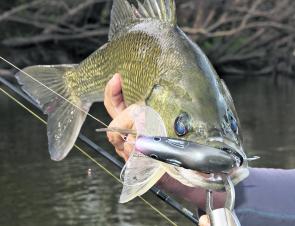

Check out the depth of colour and finish on these Kuttafurra lures.

Hand carving a set of mouse ears is a neat bit of work.
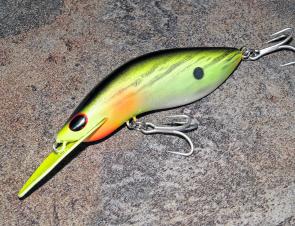
While the shape might be well known, the paintwork on Aaron’s lures is all his own.
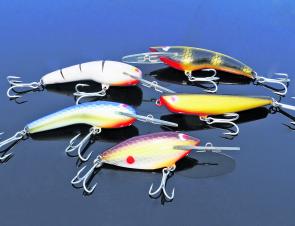
HJ lures have a neat range of very versatile tropical estuary lures.
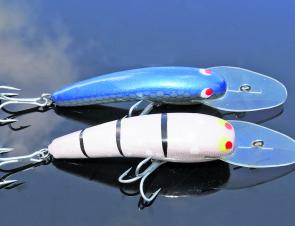
Same profile but different widths enables HJ lures to provide different levels of buoyancy in virtually the same lure. In this case a Flat Arze and a Rats Arze.
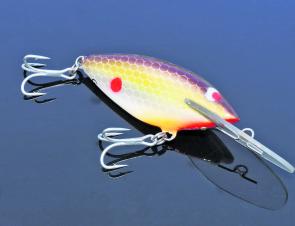
Hel’s Herring is a change up from the usual skinny barra minnow shape. It’s actually a good match for deeper profiled baitfish.




